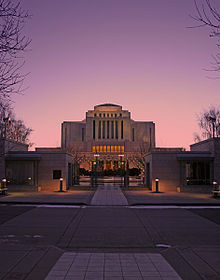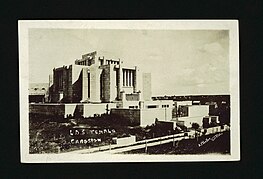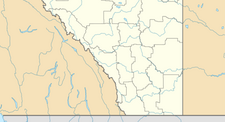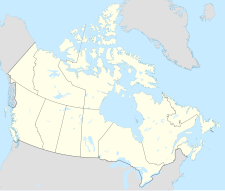Cardston Alberta Temple
| Cardston Alberta Temple | ||||
|---|---|---|---|---|
 | ||||
 | ||||
| Number | 6 | |||
| Dedication | August 26, 1923, by Heber J. Grant | |||
| Site | 10 acres (4.0 ha) | |||
| Floor area | 88,562 sq ft (8,227.7 m2) | |||
| Height | 85 ft (26 m) | |||
| Official website • News & images | ||||
| Church chronology | ||||
| ||||
| Additional information | ||||
| Announced | June 27, 1913, by Joseph F. Smith | |||
| Groundbreaking | November 13, 1913, by Daniel Kent Greene | |||
| Open house | Tours offered, 1920–23 June 6–15, 1991 (after renovation) | |||
| Rededicated | July 2, 1962, by Hugh B. Brown June 22, 1991, by Gordon B. Hinckley | |||
| Current president | F. Brent Thomas[1] | |||
| Designed by | Hyrum Pope and Harold W. Burton | |||
| Location | Cardston, Alberta, Canada | |||
| Geographic coordinates | 49°11′52.23840″N 113°18′32.50800″W / 49.1978440000°N 113.3090300000°W | |||
| Exterior finish | White granite | |||
| Baptistries | 1 | |||
| Ordinance rooms | 4 (four-stage progressive) | |||
| Sealing rooms | 5 | |||
| Clothing rental | Yes | |||
| Visitors' center | Yes | |||
| Notes | An addition was completed in 1962 and was dedicated on July 2, 1962 by Hugh B. Brown. | |||
| () | ||||
| Cardston Alberta Temple | |
|---|---|
| Location | Cardston, Southern Alberta, Alberta, Canada |
| Area | 10 acres (40,000 m2) |
| Founded | June 27, 1913 |
| Built | 1913–1923 |
| Architectural style(s) | LDS temple |
| Governing body | The Church of Jesus Christ of Latter-day Saints |
| Website | Official LDS Cardston Alberta Temple page |
| Designated | 1992 |
The Cardston Alberta Temple (formerly the Alberta Temple) is a temple of the Church of Jesus Christ of Latter-day Saints in Cardston, Alberta. It was the eighth temple constructed and is the sixth still in operation. The intent to build the temple was announced on October 12, 1912, by church president Joseph F. Smith, during the church's general conference. It was both the first temple built in Canada and outside the United States. There are four temples in the province of Alberta and ten operated by the church in Canada.
The temple's distinctive cross shape, one of two such temples built in this style (the other being the Laie Hawaii Temple), and absence of spires are distinctive characteristics of the structure. The temple was crafted by Harold W. Burton and Hyrum Pope, drawing inspiration from American architect Frank Lloyd Wright. Their design was unique in use of geometric decorative elements, and with integration of the surrounding natural environment. A groundbreaking ceremony was held on November 9, 1913.
History
The intent to construct the temple was announced by church president Joseph F. Smith on October 12, 1912. It was built on an eight-acre plot named Tabernacle Block,[2] which was given to the church by Charles Ora Card.
In 1992, the temple was declared a National Historic Site, and a plaque was dedicated in 1995.[3]
A groundbreaking ceremony, to signify the beginning of construction, took place on November 9, 1913, with Smith presiding and was attended by local church members and community leaders.[2]
The temple faced various challenges during its construction, including delays due to World War I. Its construction took 10 years, with the final two years dedicated to interior furnishing and preparation for public use.[4]
As construction began, the Relief Society General Board started a penny subscription. They saved a penny each week, allowing them to contribute more than $13,000 to the construction of the Cardston Alberta and Laie Hawaii temples.[5]
The temple was dedicated on August 26, 1923, by church president Heber J. Grant.[2][6] The site expanded to more than 10 acres (4.0 ha) in the mid-1950s. An addition was dedicated on July 2, 1962, by Hugh B. Brown. The first temple president was Edward J. Wood, who served from 1923 to 1948. The temple was renovated in the 1990s, with Gordon B. Hinckley rededicating it on June 22, 1991.
In 1992, the temple was designated a National Historic Site by Parks Canada.[7] A plaque at the temple shows this designation. The temple is also on the Church Historic Landmark list.[7]
The temple received the “Cardston Beautiful Annual Beautification Award” in 2010, a local award for making the city more beautiful.[2] Stan Johnson, a previous mayor of Cardston (and as of 2010, a counselor in the temple presidency), said the award was “a tremendous contribution that (was) made to the overall beautification of our community by the temple.”[2]
In 2020, like all the church's other temples, the temple was closed for a time in response to the COVID-19 pandemic.[8]
Design and architecture
The architectural style of the temple is characterized by a fusion of Grecian and subtle Peruvian influences, resembling designs of Aztec temples with traditional temple designs by the church.[9] Its architecture reflects both the cultural heritage of the town of Cardston and the spiritual significance of the church. Inspired by the designs of architect Frank Lloyd Wright, the temple embodies a fusion of Mayan-Aztec and Prairie School architectural styles.[10] At the time, the temple was unique, due to it not needing a large assembly hall. The Deseret Evening News said that the inside design would have similarities with contemporary temples, but “outside it is totally unlike any of them.”[5]
The temple has four ordinance rooms, five sealing rooms, and a floor area of 88,562 square feet (8,227.7 m2). Spanning an area of 81,700 square feet (7,590 m2) on 10 acres of land and is constructed with white granite sourced from a quarry near Kootenai Lakes in Nelson, British Columbia. The exterior features a singular central tower with a pyramid roof, hand-shaped stone, and stained-glass windows, while the interior consists of woods and materials imported from all over the world, hand-painted murals, and a sculpted water feature.[6][11]

One of the focal points of the temple is the placement at the town’s central square, enclosed within a stone wall and views of Chief Mountain. Its octagonal shape under a pyramidal capped roof and Greek cross layout with arms facing cardinal directions are distinct features that symbolize its historical significance.[12]
Incorporated into the design are symbolic elements from the Bible, which provide deeper spiritual meaning to the temple's appearance and function. Symbolism is an important subject to members of the church. The temple is situated on top of a small hill with prairies. The landscaping around the temple features large trees, flower gardens, and paved walkways surrounding the temple.
Renovations
The temple has undergone two major renovations to preserve its structural integrity, update facilities, and enhance its spiritual and aesthetic appeal. The most significant renovation project commenced in 1988.[13]

The renovations ensured the temple's compliance with contemporary building standards and accommodated the evolving needs of the church and its members.[14]
Some aspects of this modernization included updates to the electrical and mechanical systems, adding an entryway to the front of the building, and renovating the interior. These enhancements were made with consideration of its original decorating and design. Throughout the renovation process, care was taken to maintain the temple's historical significance. To ensure the renovations maintained the original design ethos while incorporating modern advancements, attention was given to the architecture and refurbishment of the interior.[14]
The renovated temple was rededicated on June 22, 1991, by Gordon B. Hinckley.[2]
Cultural and community impact
In 1887, Charles Ora Card and other members of the church came to the area as refugees and established a settlement at Lee Creek, Alberta, now Cardston. A tabernacle was built to support the church's membership expansion. Cardston was chosen for the site to construct a temple in Canada. Since the church already owned the land where the tabernacle stood, the decision was made to dismantle it and build the temple in its place.
The temple has made an impact on both the cultural landscape and the local community. Since its establishment in 1913, the temple has been a place of worship for members of the church, while also representing the history of the pioneers who settled the area. At the time, the temple symbolized growth and expansion of the church beyond the United States.
The temple and its surrounding grounds often serve as a gathering place for various community events, including open houses, weddings, church activities, worshiping God, and performing ordinances and ceremonies members consider sacred. These events highlight the temple's role in fostering a sense of community and promoting mutual understanding among residents of diverse backgrounds.
The government of Canada named the temple a Historic Site on September 16, 1995.[2]
Presidents or matrons
Since its dedication in 1923, the temple has been overseen by a series of temple presidents and matrons. Each typically serve a term of three to five years, except the first president, who served for 25 years. The temple president is responsible for the administration of its operations and spiritual guidance for both patrons and staff.[15]
The first temple president, Edward James Wood, served from 1923 to 1948. Under his leadership, the temple established itself as a center of spiritual activity and community engagement in Cardston, Alberta.[15] As of 2022, Forast Brent Thomas is serving as temple president.[15]
Other notable temple presidents, or matrons, include Merlin R. Lybbert (1994–97); Elaine L. Jack (1997–2000); and Ardeth G. Kapp (2000–03).[15]
Admittance and use
The temple is a central place of worship and spiritual ceremonies for members of the church. Entry into the temple is available to those who hold a valid temple recommend.
The temple is used for living and proxy (acting on behalf of someone who has passed on) ordinances such as baptisms for the dead, endowment ceremonies, and sealings which are fundamental to church doctrine.
Before its dedication, the temple was open to the public during an open house. This allowed individuals of all faiths to experience the temple's architecture and learn about the practices and beliefs of the faith.
The temple was dedicated on July 27, 1913, by Joseph F. Smith. An addition was dedicated on July 2, 1962, by Hugh B. Brown, and following renovations, it was rededicated on June 22, 1991, by Gordon B. Hinckley.[14]
Gallery
- Laying of last stone on the temple
- Capstone laying on Cardston Temple
- A close-up of the side of the temple
- Modern photo of the temple
See also
Temples in Alberta ()
|
- Comparison of temples of The Church of Jesus Christ of Latter-day Saints
- Torleif S. Knaphus — sculpted the large bas relief titled Christ the Fountainhead on the exterior of the building and also the life-size oxen holding the baptism font
- LeConte Stewart - painted murals and other art work in the temple
- List of National Historic Sites of Canada in Alberta
- List of temples of The Church of Jesus Christ of Latter-day Saints
- List of temples of The Church of Jesus Christ of Latter-day Saints by geographic region
- Temple architecture (Latter-day Saints)
- The Church of Jesus Christ of Latter-day Saints in Canada
References
- ^ "New Temple Leaders Called to Serve in 2022", Newsroom, LDS Church, 24 October 2022 [26 May 2022], retrieved 24 October 2022
- ^ a b c d e f g "Cardston Alberta Temple | Church News Almanac". Almanac. Retrieved 2024-02-02.
- ^ "Temple of the Church of Jesus Christ of Latter Day Saints National Historic Site of Canada", Canadian Register of Historic Places
- ^ "Cardston Alberta Temple | ChurchofJesusChristTemples.org". Temples of The Church of Jesus Christ of Latter-day Saints. Retrieved 2024-02-02.
- ^ a b "The First Modern Temple". history.churchofjesuschrist.org. Retrieved 2024-02-02.
- ^ a b "Cardston Alberta Temple". www.churchofjesuschrist.org. Retrieved 2024-02-02.
- ^ a b "The First Modern Temple". The Church of Jesus Christ of Latter Day Saints. Retrieved 2024-05-21.
- ^ Stack, Peggy Fletcher. "All Latter-day Saint temples to close due to coronavirus", The Salt Lake Tribune, 26 March 2020. Retrieved on 28 March 2020.
- ^ "Cardston Temple Centennial: Monument of Faith". news-ca.churchofjesuschrist.org. 2023-08-25. Retrieved 2024-02-02.
- ^ "Temple of the Church of Jesus Christ of Latter Day Saints National Historic Site of Canada". www.pc.gc.ca. Retrieved 2024-02-02.
- ^ "Cardston Alberta Temple | ChurchofJesusChristTemples.org". Temples of The Church of Jesus Christ of Latter-day Saints. Retrieved 2024-02-02.
- ^ "Temple Dimension Statistics | ChurchofJesusChristTemples.org". Temples of The Church of Jesus Christ of Latter-day Saints. Retrieved 2024-02-02.
- ^ "The First Modern Temple". history.churchofjesuschrist.org. Retrieved 2024-02-08.
- ^ a b c "Cardston Alberta Temple | ChurchofJesusChristTemples.org". Temples of The Church of Jesus Christ of Latter-day Saints. Retrieved 2024-02-08.
- ^ a b c d "Presidents and Matrons of the Cardston Alberta Temple | ChurchofJesusChristTemples.org". Temples of The Church of Jesus Christ of Latter-day Saints. Retrieved 2024-02-08.
Further reading
- Anderson, Paul L. (July 1977), "First of the Modern Temples", Ensign
- Gates, Susa Young (October 1923), "Dedication of the Alberta Temple", Improvement Era, 26 (12): 1139–1141
- Jenson, Andrew (October 1923), "Elder Andrew Jenson (Assistant Church Historian.)", [General] Conference Report, pp. 125–132
- Anderson, Paul L. (July 1978), "Paintings from the Alberta Temple", Ensign
- Brown, Hugh B. (August 1962), "The LDS Concept of Marriage", Improvement Era, 65 (8): 570–575 (Has accompanying color photographs of interior of Cardston Alberta Temple)
- Steele, C. Frank (August 1962), "Trek to the North", Improvement Era, 65 (8): 568–569, 590–591
External links
- Cardston Alberta Temple Official site
- Cardston Alberta Temple at ChurchofJesusChristTemples.org
- Augustine, Nathan. "The Cardston Alberta Temple". Nathan's Exhaustive Guide to the Temples of the Church of Jesus Christ of Latter-Day Saints. Archived from the original on 2006-02-10. Retrieved 2006-12-26.







